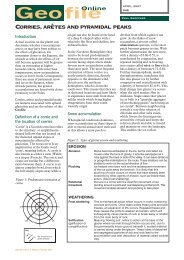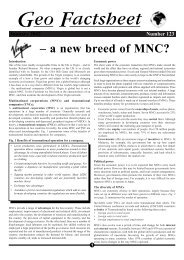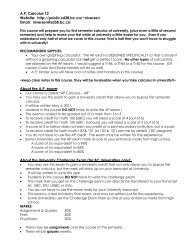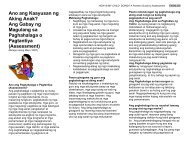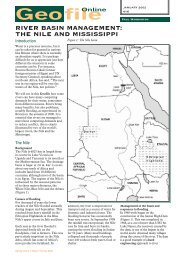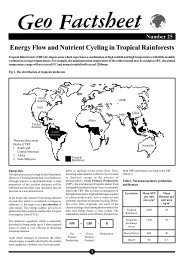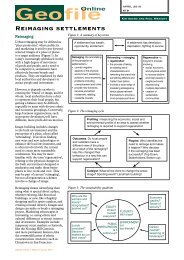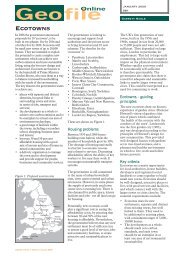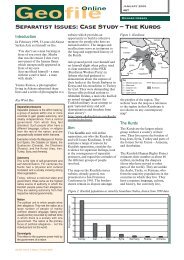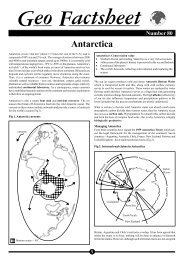Energy and Transport.pdf - Richmond School District No. 38
Energy and Transport.pdf - Richmond School District No. 38
Energy and Transport.pdf - Richmond School District No. 38
- No tags were found...
You also want an ePaper? Increase the reach of your titles
YUMPU automatically turns print PDFs into web optimized ePapers that Google loves.
Seriesgrowing vegetables in heated greenhouses can consumemore energy than transporting them from warmercountries. Locally grown seasonal vegetables are the mostenergy efficient. The role of providing an increased rangeof non-seasonal vegetables <strong>and</strong> fruit in the reduction inthe rates of cardiovascular disease in developed countriesis an area for further research <strong>and</strong> could indicate a healthbenefit from some food miles. However, attention has tobe given to the local effects of export crops on incomes,the nutrient cycle, water supplies, food prices, <strong>and</strong> l<strong>and</strong>use.Transmission of infectious diseasesThe movement of populations <strong>and</strong> livestock shapes thepatterns <strong>and</strong> distribution of infectious diseases. 60,61Reducing the spread of HIV <strong>and</strong> malaria is one of theMDGs. One method of transmission that has receivedattention is the role of truck drivers in HIV transmission(webappendix 1). African on-road settlements have anincreased risk of injuries <strong>and</strong> greater risk of HIVcompared with off-road settlements. 62 People on lowincomes who live on these corridors have strong incentiveto engage in unsafe sexual activity. Climate change isexpected to increase the range <strong>and</strong> seasons for malaria.Aviation also facilitates the rapid spread of infectiousdiseases, especially for emerging infections. 60AviationApart from its climate forcing, aviation is not associatedwith as large direct co-harms as road transport. However,airports are usually out of town <strong>and</strong> can increase roadtraffic, with its associated harms. Furthermore, claims ofthe importance of aviation to economic growth <strong>and</strong>employment are often overstated. There is considerableinternational variation in flights per head at similarincome levels, with the UK well above the Europeantrend line. The effect of investment in aviation is oftennot compared with the opportunity lost to invest in otherareas, which could provide greater employment <strong>and</strong>similar economic returns. 10 Another argument raised insupport of aviation is the economic dependence ontourism in developing countries. However, three-quartersof all UK passenger flights are within Europe, 10 with onlya small proportion to developing countries. Althoughthere will be beneficial effects in some areas, these arenot likely to be large compared with the unequal effectsof climate change.Benefits from energy intensive transportAccording to the Stern report on the economics of climatechange, commissioned by the UK Government, thewelfare costs of reducing dem<strong>and</strong> for transport is high. 64However, travel behaviour might be more amenable tochange than most models assume. A systematic reviewof case studies found that closing roads to car traffic didnot cause a corresponding increase on alternative routes. 65These models often assume that a given destinationprovides a set welfare benefit to the traveller <strong>and</strong> the timeto get there is a cost. However, over time, changes intransport infrastructure alter the nature <strong>and</strong> perceivedbenefits of destinations. Furthermore, vehicle ownership<strong>and</strong> distant holidays often function as status symbols,reducing any net benefit. 66There are areas in which motor vehicles <strong>and</strong> aviationprovide health benefits. For example, in many settingsmotor vehicles are central to the operation of health care.However, these modes are able to provide greatest benefitto society if allocated more sparingly <strong>and</strong> wisely.There are strong links between the use of fossil fuelsfor energy <strong>and</strong> physical inactivity, air pollution, <strong>and</strong>injuries. These health problems account for a substantialglobal disease burden <strong>and</strong> contribute to healthinequalities. An integrated assessment of the health <strong>and</strong>environmental effects of alternative transport is needed.Low carbon <strong>and</strong> healthy transportThere are four main strategies for moving to low-carbontransport while at the same time improving access <strong>and</strong>equity: avoiding trips; increasing energy efficiency <strong>and</strong>alternative energy sources; shortening trip distances; <strong>and</strong>changing travel modes. We look at the effect of thesestrategies on greenhouse-gas emissions <strong>and</strong> health inLondon in webappendices 2 <strong>and</strong> 3.Avoiding vehicle tripsInformation <strong>and</strong> communication technologies—eg,teleconferencing—can replace trips with electroniccommunication. The rapid development <strong>and</strong> proliferationof these technologies have transformed societies. Mobilephones offer a low-energy means of communication, <strong>and</strong>video-conferencing, email, <strong>and</strong> the internet have a largepotential for replacing physical energy-intensivemovement. Within health care there have been calls touse information technology to reduce flights by doctors. 67For freight, internet-based systems can match up sparevehicle capacity <strong>and</strong> freight needs. 68 However, the effectof such measures is complex <strong>and</strong> recent research 69 foundthat information <strong>and</strong> communication technologies areunlikely to have large effects on their own. Althoughsome trips will be substituted, others will be generated orreplaced by fewer longer distance trips. Unless theassociation between economic growth <strong>and</strong>energy-intensive mobility is altered, high-energytransport will continue to increase. Other means forreducing vehicle trips include increasing vehicleoccupancy <strong>and</strong> trip chaining, where one round tripreplaces several trips.Increasing energy efficiency <strong>and</strong> alternative energysourcesImproved engine design <strong>and</strong> changes in fuel source areimportant for reducing emissions. However, althoughtechnological solutions are attractive, their development<strong>and</strong> widespread adoption is problematic, particularly forSee Online for webappendices 2<strong>and</strong> 3www.thelancet.com Published online September 13, 2007 DOI:10.1016/S0140-6736(07)61254-9 7



